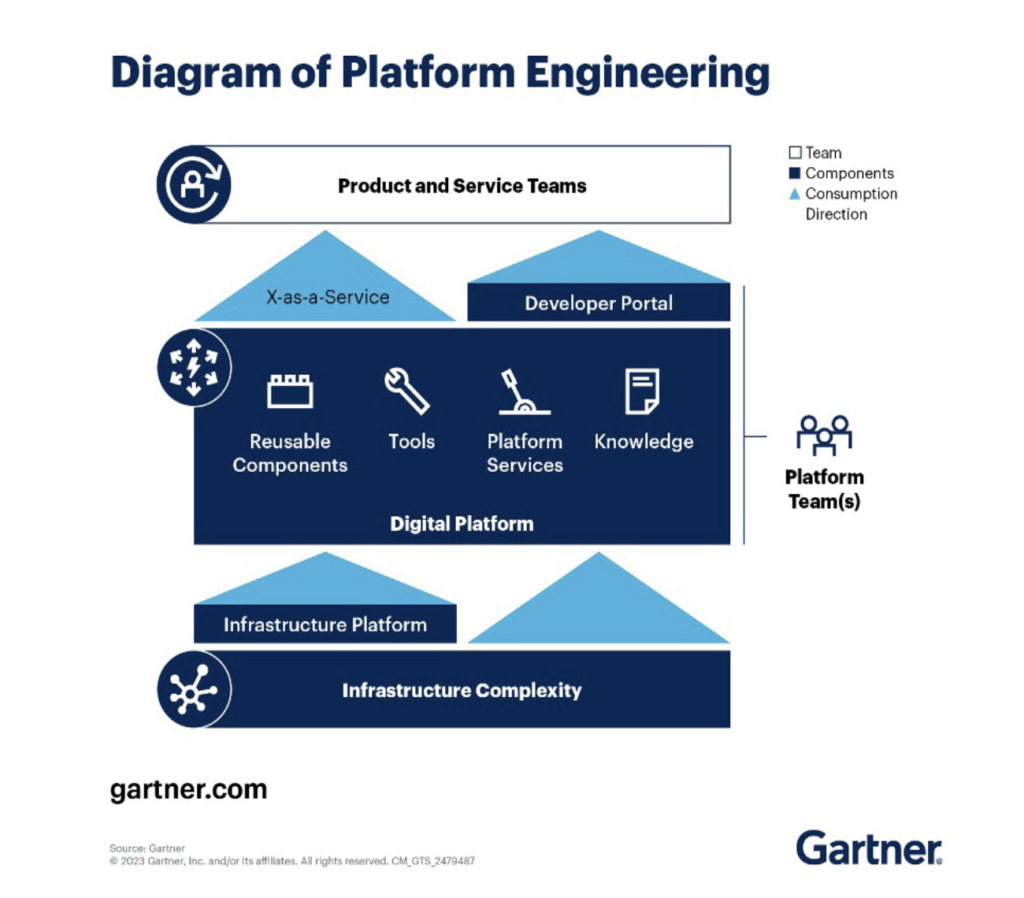

This blog is the second part of our blog series on digital transformation.
Summary
Self-service platforms powered by platform engineering give teams autonomy, speed, and consistency by providing pre-configured tools, environments, and governance through a central portal.
This reduces bottlenecks and accelerates delivery.
Action points: form a platform engineering team, create an internal developer portal, automate common workflows (e.g. provisioning, CI/CD), embed governance early, and refine continuously with user feedback.
What differentiates CIOs who are digital outperformers?
According to the Gartner, 2025 CIO Agenda (31 October 2024), one crucial element they need is to provide strong foundational platforms.
As per their findings: “CIOs must make it easier for all technology users across the business (including those outside of IT) to use digital platforms. […] They think strategically beyond the IT team when buying and deploying digital platforms and provide a compelling platform experience for all technology users.”
What are self-service platforms?
Self-service platforms are advanced digital ecosystems that empower developers, data analysts, and business users to independently manage and execute their tasks without depending on traditional IT support or manual intervention.
One of the key advantages of self-service platforms (such as Calibo) is their ability to significantly accelerate the speed to value in the digital transformation journey.
By enabling faster product delivery and quicker realization of business value, these platforms allow organizations to rapidly adjust to market demands and seize opportunities that would be otherwise delayed without their use.
This agility in deployment and operation ensures that businesses remain competitive and relevant in an ever-evolving landscape.
Furthermore, platforms like Calibo save time and money for enterprises by connecting their underlying infrastructure. Organizations don’t have to set up large teams just to build such platforms on their own, thus optimizing resource allocation and enhancing operational efficiency.
These platforms offer a streamlined, “paved road” approach, supplying users with pre-configured tools and environments crucial for fast product development and operational effectiveness.
The integration of self-service platforms has become a critical strategy for boosting operational efficiency and fostering innovation.
Driven by the robust capabilities of platform engineering, they lead the way in transforming conventional workflows into agile, self-sufficient systems.
Thus, the foundation of successful self-service platforms lies in platform engineering, which provides the structural and technological backbone necessary for these platforms to thrive.
Calibo is a self-service platform enabled by platform engineering, or in other words, a self-service digital and data orchestration platform.

Why is platform engineering important in digital transformation?
In its best form, a platform engineering solution, is user friendly (both for technical and non-technical users), and allows users across different departments to collaborate on one platform. It creates an improved developer experience and facilitates a single-pane-of-glass overview by IT leaders.
And that’s just scratching the surface.
Why is this important?
In the face of the complex challenges that IT and business teams are dealing with today, digital transformation emerges as a powerful enabler for organizations striving to survive in the modern business landscape.
“We believe that platform engineering is crucial to achieve digital transformation success because it’s an enabler for the simplicity, agility and guided self-service empowerment required to unleash the power of distributed innovation across the enterprise”, says Cyril Soga, CTO at Calibo.
The daily struggles of software and data engineers highlight the urgent need for an integrated digital solution, such as platform engineering, which can streamline complex workflows, enhance data accuracy, break down silos, and drive innovation across the entire organization.
This solution will facilitate agility, allowing companies to quickly adapt to technological advancements and market shifts while ensuring that their IT infrastructure aligns seamlessly with strategic goals.
As organizations embark on their digital transformation journey, platform engineering plays a crucial role by providing the necessary framework to support scalable, secure, and efficient operations. It empowers innovative teams, reduces operational burdens, and lays the foundation for a sustainable competitive edge.
What is platform engineering?
Let’s kick things off by clarifying what software engineering is all about.
At its core, software engineering involves designing, developing, testing, and maintaining software applications using structured methods and engineering principles.
It’s a mix of technical skills and project management that ensures software not only meets the necessary requirements but is also efficient and adaptable to changing needs.
In 2025, software engineering thrives on agile and DevOps methodologies, which emphasize quick, iterative development and ongoing delivery. These frameworks foster teamwork through practices like code reviews and version control, making it easier to manage changes collectively.
Plus, with an eye on user experience, modern software engineering weaves security into the fabric of the development process right from the start. This approach guarantees the software is as functional, responsive, and secure as users expect it to be.
As a building block, software engineering lays down the tools and frameworks that platform engineering extends to craft integrated development environments and systems.
DevOps has transformed application teams by enabling them to manage all aspects of a domain, from building to operation. However, this has highlighted repetitive tasks and a fragmented tech landscape, with application teams needing quick value delivery rather than expertise in complex tools like Kubernetes.
As cloud-native solutions expand, the load on release teams has increased. This is where internal developer platform teams come in, crafting processes and tools that allow product teams to efficiently deliver value without needing in-depth knowledge of cloud-native operations.
Platform engineering is focused on removing repetitive tasks and promoting self-service capabilities, which enhances developer autonomy and efficiency. While platform teams manage cloud services, application teams still handle security, but with streamlined avenues for integration and management.
Thus, platform engineering involves the creation and design of toolchains and workflows that offer self-service options for software development teams, particularly in the cloud-native context.
Platform engineers build a cohesive product known as an internal developer platform or portal (IDP), which addresses the operational needs throughout an application’s lifecycle.
The goal of platform engineering is to enhance team collaboration and reduce cognitive strain by equipping developers with the necessary tools and support, allowing them to concentrate on the crucial aspects of their work.
Examples of platform engineering initiatives include constructing continuous integration/continuous delivery (CI/CD) pipelines, self-service environment provisioning and deployments, crafting automated testing frameworks, and developing monitoring and logging tools to maintain application health.
As a foundation, software engineering provides the tools and frameworks that platform engineering builds upon to create integrated development environments and systems.
As mentioned, platform engineering is a software engineering discipline rooted in DevOps principles, aimed at enhancing development teams’ security, compliance, cost efficiency, and time-to-business value.
It focuses on building self-service toolchains, services, and processes to create an internal developer portal.
This shared, secure, and governed framework streamlines developer experiences, empowering teams to innovate and deliver value more efficiently.
What’s an internal developer portal? (IDP)
Platform engineering is at the heart of software delivery’s future, and it’s a field dedicated to establishing IDPs. So, what is an IDP?
Manjunath Bhat, (VP Analyst at Gartner®) has defined IDPs’ in his 2022 report, A software engineering leader’s guide to improving developer experience (August 2022), where he stated that “Internal developer portals serve as the interface through which developers can discover and access internal developer platform capabilities.”
The internal developer platform capabilities he refers to revolve around the concept of “platform orchestration”.
Specifically, capabilities that integrate multiple technologies and tools to automate and standardize repeatable processes – without impeding developers’ ability to innovate freely. Examples of such processes are CI/CD tooling and infrastructure provisioning.
Developer platform capabilities are a subset of the overall solution that a platform engineer enables, and the full value of the solution cannot be realized without the portal.
IDPs serve software engineering teams by providing the self-service tools essential for a cloud-native development journey.
Essentially, an IDP is a custom toolset, inclusive of services and infrastructure, built to equip developers with what they need to craft, assess, launch, and maintain software applications, all while being finely tuned to the unique objectives and requirements of their organization.

Source: Gartner Insights, Top Strategic Technology Trends, 2024
For more information about platform engineering please see our previous eBook: ”Your real life guide to platform engineering”.
And for more in-depth information on IDP’s, read our blogs “What is an internal developer portal (and why do you need one)?” or “Do you really need to build your own Internal Developer Platform/Portal?”
Don’t miss the next part of this blog series!
FAQ
Q: What is a self-service platform in the context of platform engineering?
It’s a centralized system that gives developers and teams direct access to pre-configured tools, environments, and services, so they can build and deploy faster without relying on manual handoffs.
Q: How do self-service platforms improve speed and efficiency?
By automating common workflows like provisioning and CI/CD, and embedding governance into golden paths, teams avoid bottlenecks and focus on delivering value instead of waiting for approvals.
Q: What steps should organizations take to get started?
Form a platform engineering team, create an internal developer portal, integrate automation and policy-as-code, and continuously iterate based on feedback from the teams using the platform.
Trending articles

Data orchestration: why modern enterprises need a data orchestration platform
Data is pouring in from myriad sources—cloud applications, IoT sensors, customer interactions, legacy databases—yet without proper coordination, much of it remains untapped potential. This is where data orchestration comes in.

How Enterprise Architects can get more support for technology led innovation
Enterprise Architects are increasingly vital as guides for technology-led innovation, but they often struggle with obstacles like siloed teams, misaligned priorities, outdated governance, and unclear strategic value. The blog outlines six core challenges—stakeholder engagement, tool selection, IT-business integration, security compliance, operational balance, and sustaining innovation—and offers a proactive roadmap: embrace a “fail fast, learn fast” mindset; align product roadmaps with enterprise architecture; build shared, modular platforms; and adopt agile governance supported by orchestration tooling.

Why combine an Internal Developer Portal and a Data Fabric Studio?
Discover how to combine Internal Developer Portal and Data Fabric for enhanced efficiency in software development and data engineering.

The differences between data mesh vs data fabric
Explore the differences of data mesh data fabric and discover how these concepts shape the evolving tech landscape.

More from Calibo
One platform, whether you’re in data or digital.
Find out more about our end-to-end enterprise solution.